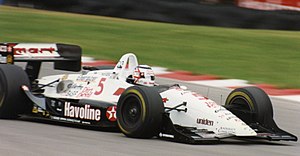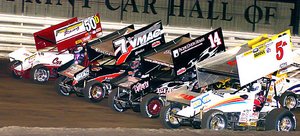Open-wheel
Open wheel car is a term for cars, usually purpose-built racecars, with the wheels located outside the car's main body, as distinct from cars which have their wheels below the body or fenders, in the manner of most street cars, stock cars, or touring cars. Open-wheel racing includes many types and levels of motor racing including Formula One, American Championship Car Racing (Champcar, IRL), sprint car, midget car, and others.
A typical open-wheeler has a minimal cockpit sufficient only to enclose the driver's body, with the head exposed to the air. In modern cars, the engine is located directly behind the driver, and drives the rear wheels. Depending on the rules of the class, many types of open-wheeler have wings at the front and rear of the vehicle, as well as a very low and virtually flat undertray that helps achieve additional aerodynamic downforce pushing the car on to the road.
Most open-wheeler races are on dedicated road race circuits. Some major races are held on temporary street circuits, and in the US many are held on oval "superspeedways"—most notably the famous Indianapolis 500 in Indianapolis, Indiana.
Open-wheel vehicles, due to their light weight, aerodynamic capabilities, and powerful engines, are often considered the fastest and most exciting to drive racing vehicles available, and the best way for aspiring racers to learn their craft. Virtually all Formula One drivers spent some time in various open-wheel categories before joining the F1 ranks. However, because the cars do not particularly resemble road cars, and the aerodynamics favour leading drivers over tailing ones thus making overtaking difficult (not to mention the fragility of the cars making the bumping and jostling common in touring and stock car racing impossible), only a few open-wheel categories draw significant crowds.
Driving an open wheel car is substantially different from driving a car with fenders. Although the lower weight of an open wheel racecar allows for better performance, the exposure of the wheels to the airstream causes a very high aerodynamic drag at high speeds (the top of the tire is moving at double the speed of the car, and aerodynamic drag force varies with the square of the speed). The visibility of the wheels to the driver makes a high degree of precision possible in their placement; on the other hand, wheel-to-wheel contact is dangerous, particularly when the forward edge of one tire contacts the rear of another tire, and is suddenly and powerfully flung upwards.
Notable categories of open-wheeler racing include:



